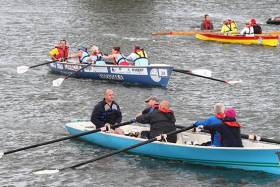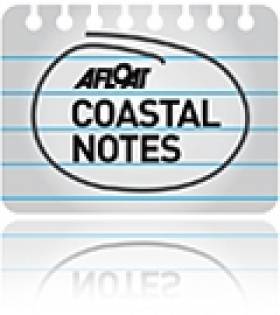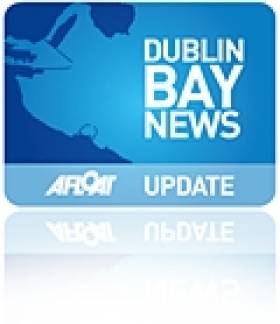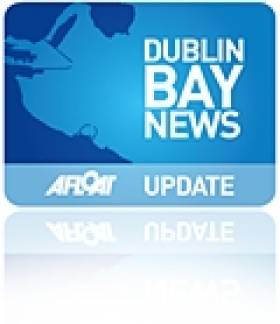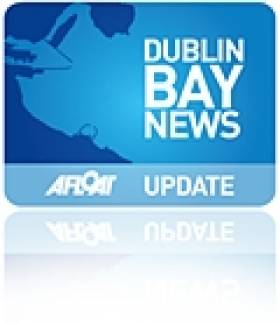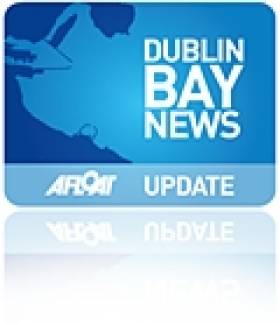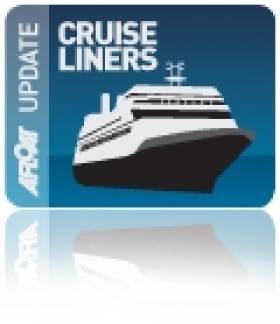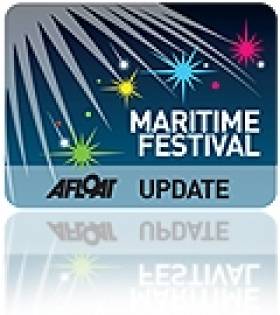Displaying items by tag: Dublin Bay Cruises
Excursion Vessel Fresh from Overhaul to Resume Dublin Bay Cruises On St. Patrick's Weekend
Operator Dublin Bay Cruises excursion vessel St. Bridget has completed an annual overhaul at Howth Boatyard and returned to the capital’s Grand Canal Dock this morning in preparation for the forthcoming season, writes Jehan Ashmore.
St. Bridget was observed off the Baily Lighthouse, on the Howth Peninsula, where the feature is one of many prominent coastal landmarks that line the beautiful expanse of Dublin Bay. The operator of boat trips and cruises is to resume service on the day preceding St. Patricks Day which this year falls on a Sunday.
In addition to made-made structures, there are wonderful opportunities to take in the marine life-life based on seven excursions, with embarkation available from Dublin City Centre, Dun Laoghaire Harbour and Howth Harbour. There are also tours from Howth around Ireland’s Eye, and from Dun Laoghaire circling Dalkey Island and into Killiney Bay along with the backdrop of the Wicklow mountains.
In the meantime, this morning the St. Bridget arrived to Dublin Port which involved the busy scene of shipping activity, before the 26m vessel reached the Tom Clarke (East Link) Toll-Bridge. At that stage, the bridge's opening-span of 45m was raised to enable the vessel to transit through into the Dublin ‘Docklands’ stretch of the River Liffey.
No sooner had St. Bridget passed under the bridge, the vessel turned into the nearby loch gate (Ringsend Gut) of the Grand Canal Dock basin on the south side of the city. This is where the vessel routinely occupies a berth during the winter months, however it won’t be long before its’ role will see excursionists embark in eagerness to take in the wonderful sights of the capital’s distinctive horse-shoe shaped bay.
Stena Ship Remains Docked in Dun Laoghaire Where 'Howth Ferry' Is the Only Operator in Town
#DublinBay - As Afloat previously reported the recent arrival of Stena Carrier to Dun Laoghaire Harbour was a surprise to many an onlooker as the imposing vessel towered above Carlisle Pier, writes Jehan Ashmore.
Stena Carrier is the largest ever ro-ro (freight-ferry) ship to enter Dun Laoghaire Harbour having anchored in Dublin Bay for over a week.
The call to the harbour was to permit carrying out surveys of the 182m long vessel. Furthermore, Afloat can reveal that works also involved the ro-ro's landing gear and the loading of stores at Carlisle Pier (see related story). The ship remains in port apparently awaiting a new charter.
The 2004 Italian built '4Runner' class Stena Carrier is operated by Stena RoRo, part of the Stena group of shipping interests and not to be confused with their ferry division Stena Line.
At 21,000 gross registered tonnage Stena Carrier surpasses the no-longer in service 19,000grt High-Speed Service (HSS) Stena Explorer. The HSS car-carrying catamaran craft operated the Dun Laoghaire-Holyhead fastferry seasonal route until a final crossing from the Irish port took place from St. Micheal's Pier (see related story) in September 2014.
In the following year, Stena officially announced to confirm the service be withdrawn and that the HSS would no longer return that season. This marked the end of the historic Ireland-Wales link dating back for more than 150 years. The move saw Stena consolidate existing services in neighbouring Dublin Port where operations to Holyhead are served by two ferries.
The Stena Carrier's location alongside Carlisle Pier is opposite to the East Pier where the harbour's only passenger carrying operator is Dublin Bay Cruises. They advertise the cruises as the 'Howth Ferry' with a sign placed at the beginning of the East Pier.
From the pier's jetty is where the 96 passenger capacity St. Bridget embarks and disembarks those travelling on trips. The vessel is not strictly a ferry, given it is not used by commuters but is based on excursion work. This involves a network of cruise leg options linking the capital port and both harbours.
Prior to the arrival of Stena Carrier, the ro-ro vessel in recent weeks was on charter to P&O Ferries on their Dublin-Liverpool service.
The ships's port of registry is Frederikshavn in Denmark. This is where Stena Line operate a short sea link (3.5hrs) to Gothenburg, Sweden. The west coast Swedish city is where Stena RoRo and the ferry operator's headquarters are based.
Hello and welcome aboard this week’s edition of your maritime programme Seascapes, shortly we’ll be talking to Eugene Garrihy of Dublin Bay Cruises out on the water aboard the St Bridget in Dublin Bay .......... Seamus Maguire will be linking up with us from our Sligo Studios where he has all the details on the All Ireland Coastal Rowing Championships and the inaugural Donegal Bay Maritime Festival .......our intrepid duo of Laura Hannon and Sarah Murphy bring us a further selection of reports from the Shore Shots Film Festival held in Sligo in April..they were there for Seascapes so this week in Part Two we feature ace surf photographer Tim Nunn and former professional surfer Fergal Smith ........first this week to the KBC Laser Radial World Championships opening ceremony which took place last Sunday in Dun Laoghaire in brilliant sunshine hosted by the Royal St George Yacht Club and the Dun Laoghaire Harbour Company we were there and as the forty eight flags of the attending countries were held aloft in the Dun Laoghaire Rathdown County Council offices we spoke to David Kelly , Chairman of the event ......
Well from David Kelly and Eric Faust we spoke next to the Harbour Master Captain Simon Coate ....
At the event we also met Con Murphy; Louis Monk; Gareth Craig of Fotosail and many other friends of the programme, a few words from the Commodore of The Royal St George Yacht Club – Justin McKenna.....
You can read and see more about the KBC Laser Radial World Championships in Dun Laoghaire on the Seascapes webpage.....
Next to Dublin Bay and Dublin Bay Cruises who operate a fine vessel the St Bridget taking natives and visiting tourists across the bay to Dun Laoghaire and Howth we’ll hear about the BioSphere that is Dublin Bay on next weeks edition of Seascapes with and we’ll have a word with Catherine McCloskey of Failte Ireland on the “Breath of Fresh Air” initiative however on Monday of this week as the KBC Laser Radial World Championships were in full swing in the waters out off Dun Laoghaire we left the quayside at Sir John Rogersons Quay just down river from the Samuel Beckett Bridge and talked to Eugene Garrihy about the company and how it all began .....
As we motored out in the bay we met the Boskalis company's dredger the Freeway heading into the port ....we’ll have more here on Seascapes next week on Dublin Bay Cruises and the BioSphere with Dr Favel Naulty and hear from Caroline McCloskey of Failte Ireland about “A Breath of Fresh Air” , we can heartily recommend a voyage out on the water it’s a very comfortable and unique experience no matter what part of this island you are from ........and they don’t sail in adverse weather conditions .........you get a great sense of the scale of the port -the marine traffic the bay, the scenery and the wildlife ...
In our Seascapes competition this week you can win copies of “Shackleton’s South” as retold by John Mac Kenna in a “Real Reads” edition for youngsters with illustrations by Maurice Pierse if you can name the last vessel on which Sir Ernest Shackleton sailed in the Southern Ocean before his passing (hint the Cabin from the vessel is being restored in the West) ......answers on a postcard to Seascapes , RTE Radio 1, Fr Mathew Street , Cork or by email to [email protected]
Next to Donegal where the inaugural Donegal Bay Maritime Festival and the All Ireland Coastal Rowing Championships are taking place , we can hear from Seamus Maguire who is in our Sligo Studios and has all the details........
One young man whom we featured on Seascapes some years ago is Westport native Fergal Smith a former professional surfer he talked to Laura Hannon for Seascapes at Shore Shots ......
Fergal Smith at Shore Shots Festival in Sligo talking to Laura Hannon , next to surf photographer , writer and film maker Tim Nunn.....
The voice of Tim Nunn at Shore Shots talking to Sarah Murphy....next week here on Seascapes Ron Coveney meets Freediving Ireland’s Feargus Callagy and he talks to Peter Conroy of Irish Tow Surf Rescue Club ..............
This week an exhibition of aerial photographs “ West Cork from the Air “ by Dennis Horgan was opened by Lord David Puttnam and the exhibition continues for the next few weeks in the Town Hall in Skibereen with stunning images of the Fastnet ; Roaringwater Bay and Crookhaven.....more on the seascapes webpage....
“Next week here on Seascapes more on Dublin Bay Cruises with Eugene Garrihy and the BioSphere with Dublin Bay BioSphere Discovery Tour Guide Dr Favel Naulty , and in a Seascapes exclusive we visit Poolbeg Yacht and Boat Club and meet our sailing Olympians to coincide with the Brasil Olympic Games opening ceremony in Rio de Janeiro we’ll hear from Finn Lynch ; Saskia Tidey ; Ryan Seaton and Matt McGovern and Annalise Murphy and the Irish Olympic Sailing team leader James O’Callaghan plus we meet the Commodore of Poolbeg Yacht and Boat Club Roger Smith and hear about their regatta which is happening on the 13th and 14th August .....................and in our final report from Shore Shots Ron Coveney talks to Freediver Feargus Callagy and Peter Conroy of the Irish Tow Surf Rescue Club...................all that and much more here on Seascapes , until next Friday night , tight lines and fair sailing.”
Marcus Connaughton
Former Aran Island Ferries Meet in Dublin's Grand Canal Dock Basin
#FormerAranFerries - In recent weeks St. Bridget another former Aran Islands ferry entered Dublin's Grand Canal Dock Basin to join Naomh Éanna, the 1956 built ship that served CIE until withdrawn from service in 1988, writes Jehan Ashmore.
The veteran 300 passenger and freight ferry is berthed in a disused dry-dock and was the topic of a TG4 documentary recently broadcast. Moored nearby is the 1977 built St. Bridget with a 120 passenger capacity that is in winter lay-up following a second season operating coastal excursions for Dublin Bay Cruises.
It is ironic the pair should be sharing company together, given plans to restore and refit the riveted 137ft hulled Naomh Éanna as a tourist attraction and return her westbound to her old homeport of Galway. Whereas St. Bridget, formerly named Galway Bay, was repositioned last year for east coast duties for newcomer Dublin Bay Cruises.
St. Bridget's season this year involved an expanded network of excursion routes linking Dublin city-centre, Howth and Dun Laoghaire harbours in addition to running an evening cruise to Killiney Bay.
According to the operator, the most popular excursion service was Dublin City via the Dun Laoghaire to Howth service. As well as these sight-seeing services St. Bridget served clients for private charters.
As the Galway Bay, not to be confused with other ferries of the same name, (notably the restored Calshot in Southampton), her career on the western seaboard included Rossaveal to Kilronan. She then had a spell on the Cleggan-Inishbofin service.
In recent times it is understood she returned to Aran service when running from Co. Clare under her current owner's sister company Doolin2Aran Ferries.
The 26m steel-hulled St Bridget is one of five passenger ships owned and operated by the Garrihy family which run both the companies. She is scheduled to resume regular sailings in April 2015.
Howth Service Revived In Advance of Holyhead Seasonal Route Closure
#DublinBay- Two commercial operators using Dun Laoghaire Harbour have opened and closed services a day apart, writes Jehan Ashmore.
As previously reported, Stena Line's HSS fast-craft that operates the Dun Laoghaire-Holyhead seasonal-only service ceased sailings today. Stena Explorer will however resume sailings for a short period over the Christmas and New Year periods.
Last Sunday, Dublin Bay Cruises revived the direct Dun Laoghaire-Howth Harbour cruise which Afloat reported last year when the operator first launched their inaugural season.
Back by popular demand the 90 minute excursion trip across Dublin Bay sees the 120 passenger St. Bridget serve this scenic route.
In total there are five cruise options that DBC have to offer in Dublin Bay involving calls in Dun Laoghaire, Howth and Dublin Port where St. Bridget berths along the city quays.
At weekends the operator runs an evening cruise departing Dun Laoghaire into Dublin Bay which includes a transit of Dalkey Sound leading into Killiney Bay.
All cruises will cease operating on 30 September. For information visit: www.dublinbaycruises.com or contact: (01) 9011757
#DublinBayCruises – Sailings are underway having started yesterday as Dublin Bay Cruises continue running this weekend as well to 11,12,13 April and a full 7-day schedule will be operating from Good Friday onwards, writes Jehan Ashmore.
The St. Bridget offers five cruise excurision options; Dun Laoghaire Harbour-Dublin City Centre and reverse, Dublin City Centre-Howth and also in reverse as well to Dun Laoghaire Harbour-Killiney Bay cruises that returns to the port which is rail connected by the DART to Dublin.
Check-out below the operators website video of what makes up the life and activities to be seen on and along the coast of Dublin Bay, a natural resource on the doorstep of Dublin City. How many other European capitals can boost such a wonderful amenity?
Watch out for glimpses of seals, the Liffey's National Convention Centre at night, joggers on Dun Laoghaire's East Pier and cyclists along the neighbouring waterfront of Newtownsmith, an artist at Coliemore Harbour Dalkey, the Baily Lighthouse and Ireland’s Eye.
In addition a fleeting shot of a recent visitor to Dublin Port that Afloat.ie reported on of the German Navy oil replenishment tanker Frankfurt auf Main (A1412). The auxiliary oiler replenishment (AOR) tanker had called with frigates as part of a Task Group. The AOR can also handle containers for military equipment, stores and an aft deck for helicopters. So who know’s what boats and ships you may see!
Asides matters marine, there's the variety of marine wildllife and more... all out there in the expanse of the horse-shoe shaped Dublin Bay, ready to be explored and most of enjoyed as a visitor attraction experience!..
Noting that tickets of on all cruises are sold on a single-journey basis and include a voucher that allows each passenger to travel for €2 the same day on any DART train between Dun Laoghaire and Howth or embark at any station along the route.
To book tickets contact 01 90 11 757 or book online and for further details visit: www.dublinbaycruises.com/cruises/
Dublin Bay Cruises Operate for St. Patrick's Weekend
#DublinBay – This St. Patrick' s weekend will see Dublin Bay Cruises running a network of excursions across Dublin Bay linking Dublin city centre with Dun Laoghaire and Howth Harbour's, writes Jehan Ashmore.
The specialised sailings on Saturday, Sunday and the Monday (15,16 and 17 March) are in advance to the excursion operator running regular season sailings which resume on Friday 4 April.
Cruise excursions options are: Dun Laoghaire-Dublin city-centre, Dubin city-centre-Howth Harbour, Howth Harbour-Dublin city centre and the final cruise operated on each day is Dublin city-centre-Dun Laoghaire Harbour. Each of the four excursion ticket prices are for one-way only journeys.
The cruises offer great views across the expanse and beauty of Dublin Bay and notably the coastline along Dalkey to the south and Howth Peninsula to the north.
In addition to calls to the capital via the commercial port as the excursion berth is closer to the city-centre opposite the National Convention centre and where the action of St. Patrick's weekend festivities will be more apparent.
Cruises are operated by the steel-hulled 100 passenger St. Bridget which has a covered lounge area and open deck spaces to take in all the vista's. For more information visit: www.dublinbaycruises.com
Christmas Cruises Across Dublin Bay
#ChristmasCruise – Take a Christmas Cruise in Dublin Bay this festive season!... with Dublin Bay Cruises operating between Dun Laoghaire Harbour and Dublin City Centre, writes Jehan Ashmore.
The Christmas Cruises includes a complimentary mulled wine served in the heated lounge of the St. Bridget as she sails across Dublin Bay and to and from the Liffey and Dun Laoghaire Harbour.
Christmas Cruises operate every weekend (Saturday and Sunday) until 22 December with convenient locations at both destinations.
The East Pier in Dun Laoghaire Harbour and in Dublin city centre along Sir John Rogersons Quay close to the Samuel Beckett Bridge (Ferryman Bar & Hotel) which is opposite to the Convention Centre.
Christmas Cruise schedule:
10.00 East Pier, Dun Laoghaire to Dublin City Centre arrive 11.15 (one-way)
14.00 Dublin City Centre depart to Dun Laoghaire arrive 15.15 (one-way)
Customers taking the cruise can avail of concession DART tickets.
All infants travelling must be included on your booking. Prices (one way only) are for example: Adults €22 and you can even take your Bicycle for €5. To book call: (01) 90 11 757 or online: www.dublinbaycruises.com/booking
Alternatively take a well earned break on a 75 minute (city-centre to city centre) round-trip cruise departing 12 noon from Sir John Rogersons Quay from within the Docklands, through the port and out into Dublin Bay.
As previously reported earlier this year Dublin Bay Cruises launched Dun Laoghaire-Howth Harbour excursions and they are to resume in April 2014 albeit with the route including an en-route call to Dublin City Centre in both directions.
In addition to running a round-trip Evening Cruise departing Dun Laoghaire Harbour which will incorporate Dalkey Island and Killiney Bay.
#LinerQM2 – A once in a lifetime opportunity to see fantastic close-up views of the giant Queen Mary 2 (QM2) during the liner's historic inaugural call off Dun Laoghaire Harbour are available with a Dublin Bay Cruises excursion, writes Jehan Ashmore.
The Dun Laoghaire based operator is running two special cruises to circle the 2,620 passenger QM2, the world's only liner during her 'anchorage' call next Thursday (16 May). Cruises depart from the East Pier (15.30 and 17.00) and head into Dublin Bay where the 151,400 tonnes Cunard Line 'flagship' will tower above the excursion boat St. Bridget.
Queen Mary 2 was built at the famous shipyard of Chantiers de l'Atlantique, St. Nazaire, France and cost €659m (US$800 million). The liner entered service in 2004 and to give a sense of her sheer size, she is 1,132 feet long, 236 feet high, 135 feet on the beam and has a draft of 32 feet.
Among the facilities, there are 15 restaurants and bars, five swimming pools, a casino, ballroom, theatre, spa-club, the only planetarium at sea and a 3D cinema. The Bermuda flagged liner which has 14 decks has a crew of 1,200.
She was named after the original Queen Mary which remains moored as a static floating hotel in Long Beach, California. Uniquely the Queen Mary 2 continues the tradition of the trans-Atlantic 'liner' which reflect a bygone era of the classic voyage between Southampton and New York.
Her call follows her predecessor the 70,000 tonnes Queen Elizabeth 2 (QE2), which twice made anchorage calls offshore of Dun Laoghaire more than a decade ago.
Arrive By Sea!...to the Dublin Bay Prawn Festival
#FestivalExcursion-Those heading for the Dublin Bay Prawn Maritime Festival (26-28 April) in Howth may consider an alternative and new way of reaching the north Co. Dublin fishing harbour with Dublin Bay Cruises which began operations last week, writes Jehan Ashmore.
The excursions run between Dun Laoghaire (East Pier) and Howth and are offered as a one-way trip (in either direction) between the harbours.
Passengers will be able to make their way back to the city-centre from either Dun Laoghaire or Howth harbours by taking the DART train (concessionary price) or use of other public transport links.
For the festival, Dublin Bay Cruises are also providing special 'Prawn Festival Cruises' on Saturday (27 April) with cruises departing Howth Harbour (at 13.30 and 15.30). These cruises will head out around Howth Peninsula and into Dublin Bay before returning back to the harbour.
All the excursions are operated by 'St. Bridget', a 26m steel-hulled vessel with a capacity for around 100 passengers and which has a bar facility serving light refreshments.
In addition there are shorter trips from Howth Harbour to Ireland's Eye and 'round' the island excursions which are operated by Ireland's Eye Ferries and Island Ferries.
Also taking place on the Saturday, as previously reported on Afloat.ie, there is to be a Prawn Push in aid of Howth RNLI beginning at 3pm.


























